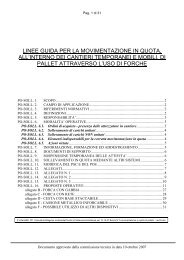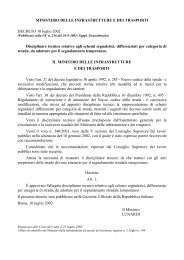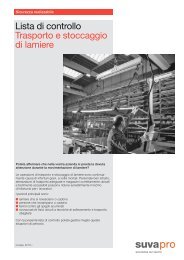Riconquistiamo il paesaggio - ACCA software SpA
Riconquistiamo il paesaggio - ACCA software SpA
Riconquistiamo il paesaggio - ACCA software SpA
Create successful ePaper yourself
Turn your PDF publications into a flip-book with our unique Google optimized e-Paper software.
Riconquistare <strong>il</strong> <strong>paesaggio</strong><br />
of years, and is, nowadays, one of the most significantly altered hotspots in the world.<br />
However, in the last years a significant increase in forest cover has been measured.<br />
These new patterns are independent from planned conservation strategies and appear<br />
to have a substantial impact on landscapes and biodiversity. We used three landuse/land-cover<br />
maps (from 1960 to 2000) covering the Italian peninsula to analyze<br />
the pattern of land-use/land-cover change. We measured an increase in forests, especially<br />
in mountains, an increase in artificial areas, especially in coastal zones, and a<br />
decrease in pastures. Intensively cultivated areas showed a limited decrease wh<strong>il</strong>e extensively<br />
cultivated ones showed a marked decrease. In the same period mammal<br />
and bird species followed a sim<strong>il</strong>ar pattern, with forest birds, ungulates and carnivores<br />
increasing, and typically Mediterranean species decreasing. We suggest that our results<br />
may provide important information, which could be useful for conservation planning<br />
in the entire Mediterranean hotspot. We suggest that an increasing conservation<br />
effort should be made to protect the Mediterranean-type forests and scrublands, as<br />
well as traditional agricultural practices. Moreover, future conservation efforts should<br />
consider the broad socio-political and ecological processes that are most likely to occur<br />
across the whole hotspot, especially along coastal areas, and the network of protected<br />
areas should be functionally integrated in a conservation strategy that includes<br />
the human dominated landscape.<br />
During the past several thousands years, human population have had an increasingly important<br />
role in the modification of the environment (W<strong>il</strong>liam & Turner 1992; Ojima et al. 1994; Vitousek<br />
et al. 1997; Sanderson et al. 2002). Forest covered about 50% of the Earth’s land area 8,000 years<br />
ago, as opposed to 30% today (Noble & Dirzo 1997), and agriculture has expanded into forests,<br />
savannas, and steppes in all parts of the world (Matson et al. 1997). Considering only the<br />
last century, human population increased from less than 2 b<strong>il</strong>lion to more than 6 b<strong>il</strong>lion people<br />
(Loh & Wackernagel 2004). About half of the ice-free land surface has been substantially modified<br />
by human activities over the last 10,000 years (Lambin et al. 2003), and landscape processes,<br />
biogeochemical cycles, and ecosystem functions have been deeply impacted (Houghton<br />
1994; Vitousek et al. 1997; Reid et al. 2000; Lambin et al. 2003).<br />
Habitat loss, in particular, is usually regarded as one of the most important factors causing the<br />
global biodiversity crisis (Sala et al. 2000) and, in general, it has been proved to be a remarkably<br />
good predictor of the number of threatened or extinct endemic species in biodiversity hotspots<br />
(Brooks et al. 2002). Land-use/land-cover changes and the associated habitat loss are a consequence<br />
of natural and human driven processes (Houghton 1994; Ojima et al. 1994; Pimm et al.<br />
1995; Vitousek et al. 1997; Pimm & Lawton 1998; Sanderson et al. 2002), and many studies indicate<br />
high rates of change since the 1970s associated to high human population growth rates,<br />
land-use intensification, and loss of natural habitat (Houghton 1994; Dobson et al. 1997; Matson<br />
et al. 1997; Lambin et al. 2003; Sodhi et al. 2004; Brown et al. 2005; Lepers et al. 2005).<br />
The Mediterranean basin, one of the four most significantly altered hotspots on Earth (Myers<br />
et al. 2000), has been intensively affected by human populations for thousands of years especially<br />
along the coasts, significantly longer than any other hotspot (Covas & Blondel 1998; Lavorel<br />
et al. 1998; Blondel & Aronson 1999; Vallejo et al. 2005). As a result, only 4.7% of its primary<br />
vegetation remains; the agricultural lands, evergreen woodlands and maquis habitats that dominate<br />
the hotspot today are the result of anthropogenic disturbances over several m<strong>il</strong>lennia. However,<br />
the integration of natural ecosystems and traditional human activities is one of the reasons<br />
177





